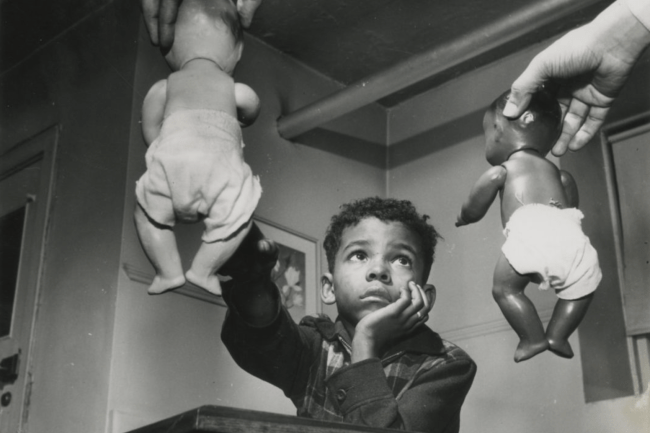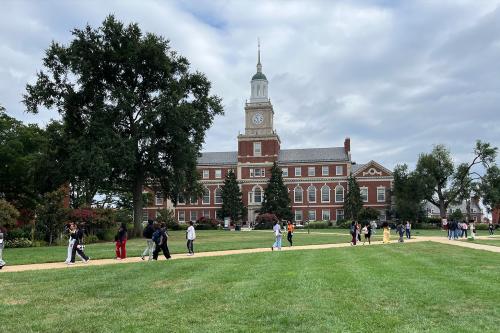Collection of 244 Works, Organized into 15 Study Sets, Advances Opportunities for Scholars and Students to Engage with Parks’s Legacy through Research, Exhibitions, and Multidisciplinary Curricula
WASHINGTON – Howard University and The Gordon Parks Foundation today announced a historic acquisition of 244 photographs representing the arc of Gordon Parks’s career over five decades. The breadth of the collection—which spans Parks’s earliest photographs in the 1940s through the 1990s—makes it one of the most comprehensive resources for the study of Parks’s life and work anywhere in the world. The Gordon Parks Legacy collection, a combined gift and purchase, will be housed in the Moorland-Spingarn Research Center. Organized thematically by subject into 15 study sets, the photographs serve as a rich repository for the development of exhibitions and multidisciplinary curricula that advances scholarship on Parks’s contributions as an artist and humanitarian.
Howard University’s acquisition is part of The Gordon Parks Foundation’s commitment to supporting initiatives that provide access to and deepen understanding of the work and vision of Parks for artists, scholars, students, and the public. Building on this partnership, the Foundation and Howard University are exploring future projects that draw on the collection to catalyze new research and joint programming.
“This landmark acquisition provides new dimension to studying the work and lasting impact of Gordon Parks through the context and resources of a university,” said Peter W. Kunhardt, Jr., Executive Director of The Gordon Parks Foundation. “Gordon embodied the many values that Howard University stands for, making it a fitting home for engaging with one of the great chroniclers of Black American life.”
“Howard University is proud to be the recipient of such an important collection of work by African American artist and photojournalist Gordon Parks,” said Dr. Wayne A. I. Frederick, President of Howard University. “Mr. Parks was a trailblazer whose documentation of the lived experiences of African Americans, especially during the civil rights period, inspired empathy, encouraged cultural and political criticism, and sparked activism among those who viewed his work. Having a collection of his timeless photographs in the Moorland-Spingarn Research Center will allow Howard University faculty, students and visiting scholars to draw on his work and build upon his legacy of truth telling and representation through the arts.”
“I am extremely excited about this historic acquisition by Howard University and this rich addition to Moorland-Spingarn’s collection,” said Ben Talton, Ph.D., Director of The Moorland-Spingarn Research Center at Howard University. “It fortifies Howard’s place as the premier institution preserving the legacy of the global Black experience. In addition to acquiring the nation’s largest Garden Parks collection, Howard University is gaining a partner in the Gordon Parks Foundation. This collection and this historic collaboration provide our students and faculty with direct access to Parks’ work and the resources of the Gordon Parks Foundation for research and teaching. As a photographer and filmmaker, Parks provided a unique narrative of the beauty and pain of the history of the United States during the second half of the 20th century.”
Among the qualities that make this acquisition distinct is the inclusion of photographs created by Parks early in his career, during the 1940s. His portraits of members of Black communities in Minneapolis and Chicago, some of which circulated in Black media outlets of the time, are crucial for understanding Parks’s emergence as a photographer working for the popular press. These communities and the Southside Community Arts Center, where Parks operated his studio and exhibited work, allowed for the creative exchange of ideas and inspiration from the talents it attracted and this confluence would forge some of Parks’s most consequential relationships.
Other highlights of the collection include early portraits of historical figures before they achieved national and international recognition, including Robert Todd Duncan, who is best known for his role as Porgy in the premiere production of Porgy and Bess and as one of the first African Americans to sing with a major opera company; Margaret Taylor Boroughs, visual artist, writer, poet, educator, and arts organizer who co-founded what is today the DuSable Museum of African American History in Chicago; renowned musical conductor Charles Dean Dixon, the first African American guest conductor of The New York Philharmonic; and stage actress Hilda Simms, who played the title role in the boundary breaking all-Black production of Anna Lucasta on Broadway.
The collection traces Parks’s progression from these early portraits of rising talents to becoming a leading photographer of Black celebrity through the subsequent decades. Represented are Parks’s mid-career works Sidney Poitier in A Raisin in the Sun, New York, New York, 1959; Duke Ellington in Concert, New York, 1960; Louis Armstrong, Los Angeles, California, 1969; among other photographs of notable figures from the period.
Following this arc, the holdings also include photographs taken later in Parks’s career of subjects representing new generations of changemakers at the height of their emergence on the cultural scene, including portraits of the iconic fashion model Iman from the 1970s, and images taken in New York of Jazz musician Miles Davis in 1981, and filmmaker Spike Lee in 1990.
Using his camera as his “choice of weapons,” Parks chronicled Black America’s struggles and triumphs throughout his career as a means of advancing social justice. This lifelong commitment is reflected in several study sets featured in the acquisition, including select works from Parks’s landmark 1956 color photo essay for Life magazine, later known as Segregation Story, which had exposed the daily realities of Black Americans living under Jim Crow law in the rural South. Also represented are Parks’s photographs of the March on Washington and leaders of the Civil rights movement, including Malcolm X and Stokely Carmichael.
“Howard University, and the Moorland-Spingarn Research Center in particular, have become a premier destination for scholars whose research lies at the intersections of race, social and political life,” said Laurence C. Morse, Ph.D., chairman of the Howard University board of trustees. “It is fitting that this tremendous collection of work by Gordon Parks be housed in Moorland-Spingarn and made available to scholars seeking to advance and enrich our understanding of not only photojournalism as a medium, but also the complex stories of Black American life through generations as depicted in Parks’ work. We are incredibly grateful to the Gordon Parks Foundation for their partnership.
ABOUT HOWARD UNIVERSITY
Founded in 1867, Howard University is a private, research university that is comprised of 14 schools and colleges. Students pursue more than 140 programs of study leading to undergraduate, graduate and professional degrees. The University operates with a commitment to Excellence in Truth and Service and has produced one Schwarzman Scholar, three Marshall Scholars, four Rhodes Scholars, 12 Truman Scholars, 25 Pickering Fellows and more than 165 Fulbright recipients. Howard also produces more on-campus African American Ph.D. recipients than any other university in the United States. For more information on Howard University, visit www.howard.edu.
ABOUT THE GORDON PARKS FOUNDATION
The Gordon Parks Foundation supports and produces artistic and educational initiatives that advance the legacy and vision of Gordon Parks—recognized as the most significant American photographer of the 20th century, as well as a writer, musician, and filmmaker, who used the arts to further “the common search for a better life and a better world.”
Through exhibitions, publications, and public programs organized in collaboration with national and international institutions at its exhibition space in Pleasantville, New York, the Foundation provides access to, and supports understanding of, the work and contributions of Gordon Parks for artists, scholars, students, and the public. Through its year-round educational programming and annual grant-making initiatives, the Foundation champions current and future generations of artists and humanitarians whose work carries on Parks’s legacy.
ABOUT GORDON PARKS
In a career that spanned more than 50 years, photographer, filmmaker, musician, and author Gordon Parks created a body of work that made him one of the most influential artists of the twentieth century. Beginning in the 1940s, he documented American life and culture with a focus on social justice, race relations, the civil rights movement, and the Black American experience. Born into poverty and segregation in Fort Scott, Kansas, Parks was drawn to photography as a young man. Despite his lack of professional training, he won a Julius Rosenwald Fellowship in 1942; this led to a position with the photography section of the Farm Security Administration (FSA) in Washington, D.C., and later, the Office of War Information (OWI). By the mid-1940s, he was working as a freelance photographer for publications such as Vogue, Glamour, and Ebony. Parks was hired in 1948 as a staff photographer for Life magazine, where he spent more than two decades creating some of his most groundbreaking work. In 1969, he became the first Black American to write and direct a major feature film, The Learning Tree, based on his semi-autobiographical novel. His next directorial endeavor, Shaft (1971), helped define a genre known as Blaxploitation films. Parks continued photographing, publishing, and composing until his death in 2006.





